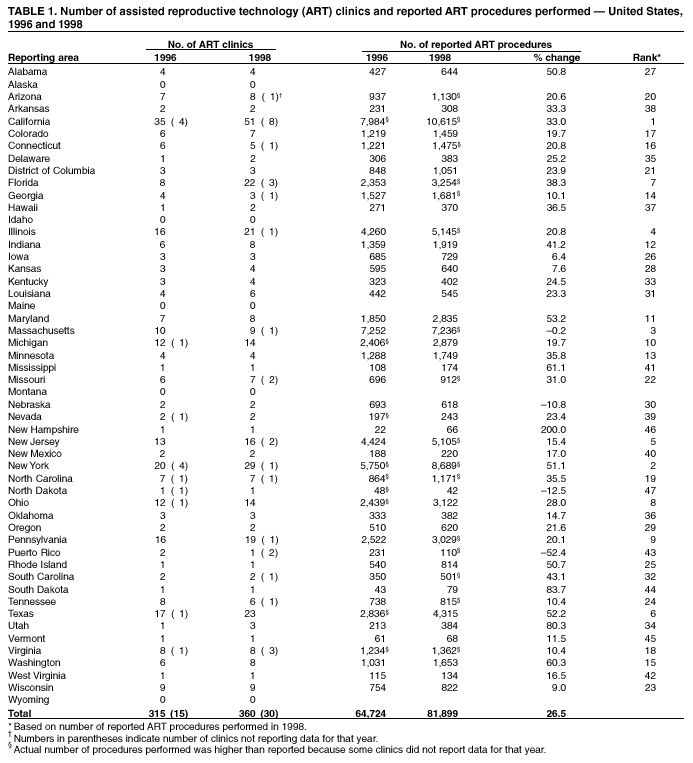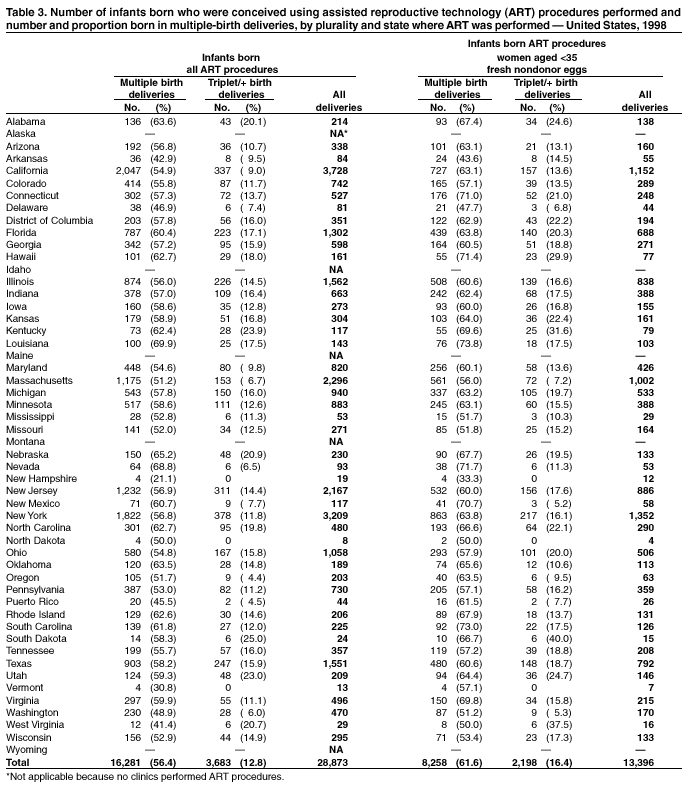 |
|
|
|
|
|
|
| ||||||||||
|
|
|
|
|
|
|
||||
| ||||||||||
|
|
|
|
|
Persons using assistive technology might not be able to fully access information in this file. For assistance, please send e-mail to: mmwrq@cdc.gov. Type 508 Accommodation and the title of the report in the subject line of e-mail. Use of Assisted Reproductive Technology --- United States, 1996 and 1998Since 1983, when the first infant was conceived from in vitro fertilization (IVF) in the United States, the use of IVF and related procedures (assisted reproductive technology [ART]) has increased substantially. In 1998, an estimated 0.7% of the 3.9 million births were the result of ART (1). ART patients are more likely to deliver multiple infants than women who conceive without treatment, and these multiple-infant births are associated with increased risks for pregnancy complications, premature delivery, low birth-weight infants, and long-term disability among surviving infants (2). This report examines statespecific use of ART in 1996 and 1998 and provides data on ART live-born and multipleinfant birth rates in 1998. Findings indicate that the use of ART is increasing in most states and that more than half the infants born as a result of these procedures are multiple births. These high-risk births contribute disproportionately to health-care costs and might negatively affect maternal and child health outcomes, particularly in states where large numbers of ART procedures are performed. The 1992 Fertility Clinic Success Rate and Certification Act* requires all U.S. clinics performing ART to report data annually to CDC for every ART procedure initiated (3). ART is defined as any procedure in which both oocytes and sperm are handled outside the body; these include IVF and gamete and zygote intrafallopian transfer (gametes or zygotes transferred into the fallopian tubes rather than the uterus). Procedures are classified according to whether the ART patient uses her own eggs or eggs donated by another woman, whether the embryos transferred were freshly fertilized or previously frozen, and whether the embryos were transferred into a gestational surrogate or a new treatment procedure was used. Clinics submit their data to CDC through the Society for Assisted Reproductive Technology reporting system (3). This report uses data from 1996, the first full year CDC collected data, and 1998, the latest year of completed data collection. State-specific comparisons of live-birth and multiple-birth rates as a result of ART require consideration of both ART type and patient age; however, because of insufficient sample sizes, age-adjusted rates could not be calculated for each state. Live-birth delivery (i.e., the percentage of procedures that resulted in the delivery of one or more live-born infants) and multiple birth rates are presented for ART procedures performed on women aged <35 years using fresh, nondonor embryos (excluding gestational surrogate and new treatment procedures). During 1996--1998, the number of ART clinics increased nationally from 330 to 390 (18%), of which 315 (95%) reported data in 1996 and 360 (92%) reported data in 1998 (Table 1). The total number of reported ART procedures increased 26.5%, from 64,724 in 1996 to 81,899 in 1998. Increases were reported for 35 of the 38 states that had complete data for 1996 (i.e., no nonreporting clinics). The states where the greatest number of reported ART procedures were performed during 1998 were California (10,615), New York (8,689), Massachusetts (7,236), Illinois (5,145), and New Jersey (5,105). ART was not performed in Alaska, Idaho, Maine, Montana, or Wyoming. In 1998, a total of 20,143 live-birth deliveries resulted from the 81,899 ART procedures. The national live-birth delivery rate was 24.7%. Nationally, 61,650 (75%) of the 81,899 ART procedures performed in 1998 were fresh nondonor; 11,228 (14%) were frozen nondonor; 5,828 (7%) were fresh donor; 1,928 (2%) were frozen donor; and 1,265 (2%) were procedures involving gestational surrogates, new treatments, or embryo banking. Live-birth delivery rates for the five ART types were 25%, 17%, 37%, 21%, and 30%†, respectively. For 27,858 procedures performed on women aged <35 years using fresh, nondonor embryos (Table 2), the live-birth rate was 32.0% (95% confidence interval: 31.4%--32.5%). The 20,143 live-birth deliveries from ART procedures performed in 1998 resulted in 28,873 live-born infants (Table 3). The number of infants born was higher than the number of live-birth deliveries because of multiple-infant births. The five states with the largest number of ART procedures performed also reported the most infants born by ART procedures. A total of 16,281 (56%) infants were multiplebirths§, 12,598 (44%) were twins. Nationally, 61.6% of the ART infants born to women aged <35 years were multiple births; 16.4% were triplets and higher order multiples. The multiple-infant birth rate for these women was 70%--74% for six states (Connecticut, Hawaii, Louisiana, Nevada, New Mexico, and South Carolina). Reported by: LA Schieve, PhD, G Jeng, PhD, LS Wilcox, MD, Div of Reproductive Health, National Center for Chronic Disease Prevention and Health Promotion; Div of Applied Public Health Training, Epidemiology Program Office; MA Reynolds, PhD, EIS Officer, CDC. Editorial Note:Data in this report indicate that ART-related multiple births are an increasingly important public health problem nationally and in many states. The proportion of infants born as a result of ART in the United States in 1998 that were multiple births (56%) was substantially higher than the overall national average of 3% (4). This rate was even higher (62%) for the most common group receiving ART procedures: women aged <35 years who used fresh nondonor eggs. The triplet and higher-order birth rate for this group was 16%, 100 times higher than the national average of 0.16% among women this age in 1998 (4). The findings in this report are subject to at least four limitations. First, not all clinics that perform ART procedures in the United States report data. Second, the incompleteness of residency data precludes the calculation of the contribution of ART to total births and multiple births among residents of each state. Some states are more likely to have nonresident ART patients, including states with military hospitals that perform ART (e.g., District of Columbia), states with clinics near borders (e.g., Kansas, Missouri, New Jersey, and Rhode Island), and states neighboring those with no ART clinics. Completeness of residency data was from 5% to 70% for 13 states and from 90% to 100% for 25 states. Among these 25 states, the proportion of ART procedures performed on in-state residents ranged from 74% to 100%. Third, the ART procedure is the unit of analysis for the surveillance data set; it is not possible to link data from multiple ART procedures performed on the same patient in a given year. Finally, these data reflect procedures performed in 1998 and resulting births (i.e., 1998 and 1999). Subsequent changes in ART technology and practice patterns that might have occurred might have affected live-birth and multiple-birth outcomes. Multiple births disproportionately contribute to infant and maternal morbidity and mortality rates. Data in this report indicate a need to reduce multiple births associated with ART. Professional organizations such as the American Society for Reproductive Medicine have guidelines on the use of judicious limits on the number of embryos transferred (5). In addition, maternal residency and other data need to be monitored closely and to be well described to understand the growing impact of ART on maternal and child health. References
* Publication L No. 102--493(42 U.S.C. 263a-1 et seq.) October 24, 1992. † Calculation excludes embryo banking procedures in which all embryos were frozen for later use. § Fetuses delivered with at least one being live-born. Table 1  Return to top. Table 2  Return to top. Table 3  Return to top.
Disclaimer All MMWR HTML versions of articles are electronic conversions from ASCII text into HTML. This conversion may have resulted in character translation or format errors in the HTML version. Users should not rely on this HTML document, but are referred to the electronic PDF version and/or the original MMWR paper copy for the official text, figures, and tables. An original paper copy of this issue can be obtained from the Superintendent of Documents, U.S. Government Printing Office (GPO), Washington, DC 20402-9371; telephone: (202) 512-1800. Contact GPO for current prices. **Questions or messages regarding errors in formatting should be addressed to mmwrq@cdc.gov.Page converted: 2/7/2002 |
|||||||||
This page last reviewed 2/7/2002
|